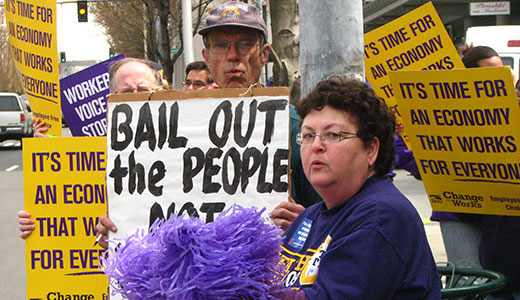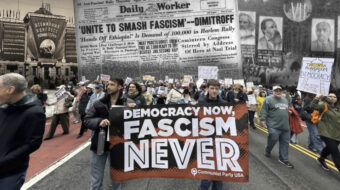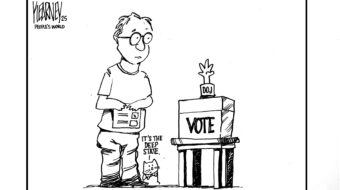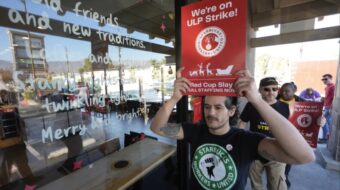
By official measure the Great Recession is over, which only goes to prove that the economics profession is as delusionary as it is dismal.
Three out of four Americans, however, aren’t drinking the Kool-Aid that the crisis is no more, according to a recent CNN poll.
No wonder!
Official unemployment is stuck at 10 percent. Unofficial unemployment is far higher. Wages are either stagnating or falling, while productivity grows at a fast clip. Households are still cutting corners and remain up to their ears in debt. The attack against the “overindulged,” “privileged” and “overpaid” public worker (and as a consequence against public services from education to homeless shelters) is in full-court-press mode.
To make matters worse, the stimulus monies are drying up for all practical purposes.
Meanwhile, in our nation’s capital the mean season has begun, as Republican lawmakers (somehow that word seems too polite for these folks) are demanding drastic cuts in the social safety net that is already in tatters, a rollback of Social Security and Medicare, and authorization for states to go bankrupt, which then turns into a Trojan Horse to renege on pension obligations to state workers.
The Republicans, who are no more than the water-carriers for the wealthiest corporations and families, won’t even make a rhetorical concession to the notion of “shared sacrifice,” choosing to demand sacrifice solely from the very people who had no hand in creating the economic crisis in the first place – our country’s working and middle classes and communities.
So for most Americans, no end to hard times is in sight.
I say “most,” because in the headquarters of U.S. corporations and finest country clubs it is “high fives” all around. The good times are back for them.
In the last two years, corporate profits climbed at the fastest pace on record – and not only on Wall Street. Non-financial companies are reporting the highest cash flow (profits after dividends and capital expenditures are subtracted) in a half-century.
Profit margins at the biggest corporations are reportedly around 9 percent and unofficially far higher, as corporations find ways to legally and illegally hide their real take (what Marxists call surplus value, of which reported profits is only a part).
What we have, then, is a “recovery” for working people that is L-shaped (in other words, flat – no recovery at all), and a profit recovery for U.S. corporations and the wealthiest families that is V-shaped (soaring upward).
And it’s not because business investment and consumer spending are strongly rebounding. I wish that were so, but it is not the case. Both remain low. What then explains this phenomenon?
Simply put, capital and labor are locked into a deadly, unequal embrace – with capital feeding off labor – while the economy barely limps along.
How long can this polarization of income continue, with tens of millions of working people at one pole and the top tier of the rich at the other, without throwing the economy into a double dip? I’m not able to give a precise answer to this, and I’m not sure if anybody can, but it is safe to say that stagnating wages and capital’s refusal to invest its trillions of dollars of idle money make the danger of a new downturn real and palpable.
Corporate executives and the wealthy seem unfazed about this danger. I guess they figure that even if the economy goes into another nosedive, they will make the have-nots pay for it much as they have over the past two years. Why stop and reroute the train, they must think, when they are doing so well?
So what are working people to do in these circumstances? Where can they turn for help? My answer is: to one another. People’s multi-racial, multi-ethnic unity and action at a higher level is of critical importance if the assault under way at local, state and federal levels is to be slowed down and then reversed.
While this assault has bipartisan elements, right-wing extremism is leading the charge and one has to be careful not to lump everybody together.
Each legislative fight has to be examined concretely with an eye to drawing to the side of working people every possible ally in this unprecedented struggle, including sections of the Democratic Party and the Obama administration.
Out of frustration it is easy to put both parties in one boat regardless of circumstances, but that is a strategic and tactical mistake. Struggles that could be won will be lost if this strategy and tactic is pursued, and defeats that could be mitigated will turn into momentous setbacks.
Working people fight on an unfavorable terrain at this moment and are unable to dictate the agenda and terms of struggle. In these conditions, broad unity and reach is essential.
This situation probably won’t change until 2012, and then it depends on that election’s outcome. In the meantime, it will take practical mass initiatives, a sound strategy, tactical flexibility, and common sense to turn things around!
Photo: Neil Parekh / SEIU Healthcare 775NW CC 2.0










